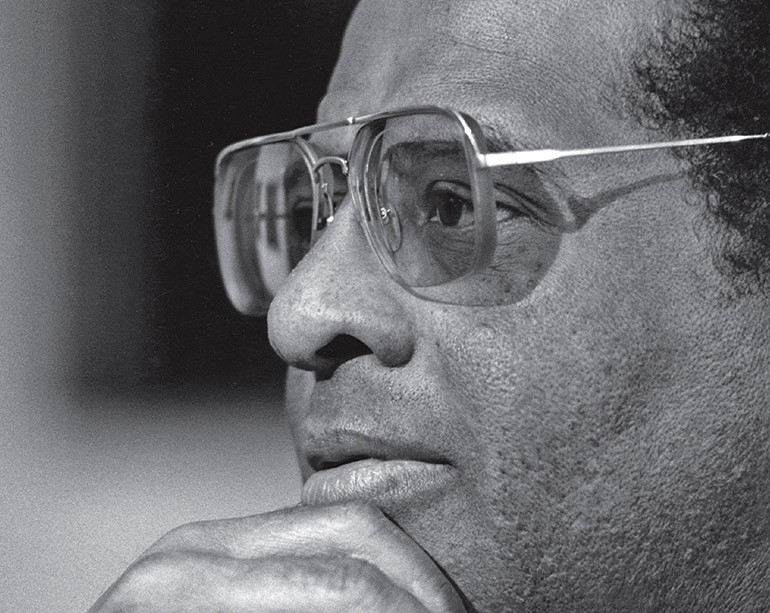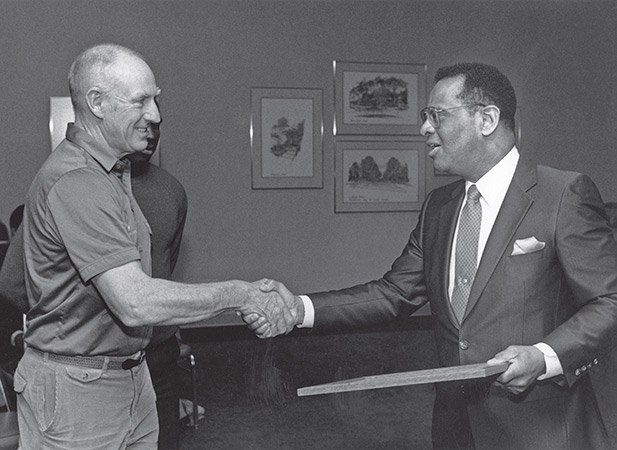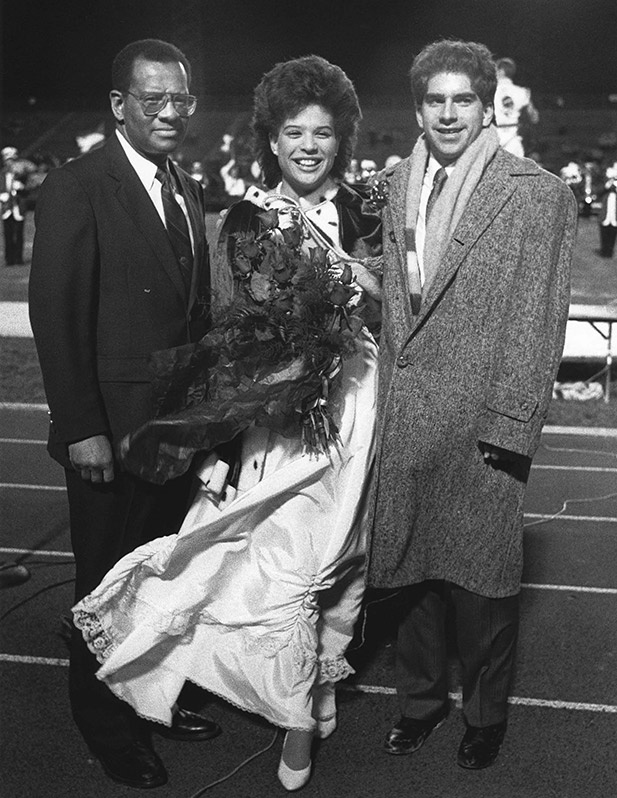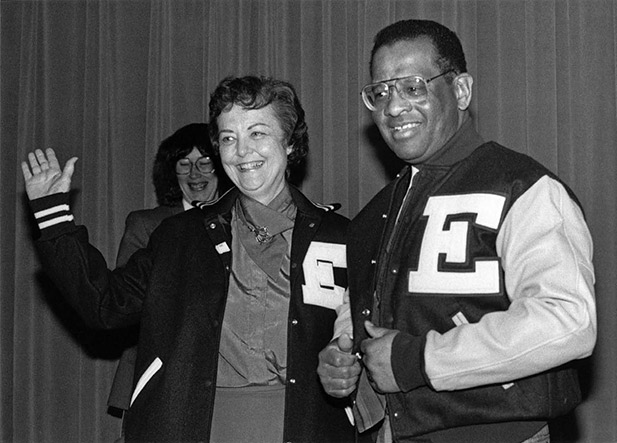
When John W. Porter was named president of Eastern Michigan University in 1979, the University's future–even its survival–was being debated on campus and around the state, particularly in the Legislature in Lansing.
By the time Porter's tenure was complete a decade later, he had led EMU through a remarkable period of achievement, growth, and stability that continues to influence the University today.
Porter's leadership and accomplishments were celebrated in early July at a memorial after the former president died in Ann Arbor on June 27 at age 80.
"To me, his most profound impact was his vision and his emphasis on having a plan and working the plan."
"When he took over, there were conversations in Lansing even about whether the University should close," recalls Donald Loppnow, an EMU professor of social work who was director of research development under Porter. "For probably the first four years of his presidency, it was about demonstrating to the Legislature that Eastern Michigan University was vital to the citizens of Michigan and served the citizens well. And that the quality of education was very cost-effective .... It was a point in the University's history where strong leadership was absolutely necessary."
Porter was the epitome of a strong leader, according to those who worked with him. He surveyed the campus and envisioned how he could strengthen the University for both its internal customers–students, faculty and staff–and for its external constituencies– the Legislature, taxpayers and parents paying for their children's education. He put together an extremely detailed plan and worked tirelessly to implement it, expecting the same commitment from those around him. As if to predict and ensure the plan's success, he gave it a bold name-"A Decade of Advancement."
Loppnow said Porter's plan centered on three phases–revitalization, stabilization and expansion. Whatever the area for improvement–enrollment, image, financial well-being, better facilities–the plan set out specific steps and created metrics for measuring success. Porter's vice presidents and other staff met regularly to ensure the plan was proceeding on schedule. Not meeting the standard was not an option.
"To me, his most profound impact was his vision and his emphasis on having a plan and working the plan," says Loppnow, who served as EMU's interim president from 2007-08 and considered Porter a mentor. "He was a great leader and innovator, (had a) very energetic management style and he emphasized the importance of strategic planning. He was perhaps one of the early disciples of Management By Objective. Every unit on campus, every administrative division and office, had objectives we were to be working on with metrics. And he knew the data about every department on campus and held people accountable."

April 27, 1 988: President Porter presents an award to Coach Bob Parks for his men's track team having won the MAC indoor invitational meet.
John Burkhardt, a professor of education at the University of Michigan, was Porter's executive assistant and director of institutional advancement for several years in the 1980s. He notes that when Porter arrived at EMU, it was still struggling to implement the state's 1963 mandate to transform Michigan's "Normal" teaching colleges into comprehensive universities. Burkhardt said Porter was brilliant at understanding the small details that work together to form the big picture of a university enterprise.
"While operating with this pretty strongly articulated view of what Eastern needed to be in 10 years, he broke it down into responsibilities for the people who worked around him so that everybody knew exactly what admissions number we needed to hit, what level of financial fundraising we needed to accomplish, what the goals were for student retention, how he was going to reposition the University in terms of its broader constituencies," Burkhardt recalls.
"And much of this was captured in documents, which he authored. They existed in notebooks, which he had in his office. As his executive assistant, he would bring me into the office and open up a notebook and have the whole next four or five years planned out, but also say, 'And this is what you need to do next week."'
Donna Welch, the youngest of nine Porter children, lived in the president's house at 600 W. Fourth St. for her last three years of high school. She recalls riding around campus in a car with her parents as her father talked about how to improve the University -everything from better signs welcoming people to campus and identifying buildings to more parking to developing a conference center and golf course like many other universities had at the time.
"He was this visionary who realized that he had to set Eastern apart from some of the other regional universities and even the University of Michigan. (He understood) what is our core, what we are about as a university and then really finding that and marketing that, and I think he did it very well," Welch says.

1987 Homecoming: President Porter with Queen and King, Kim Wright (BS89) and Allen Fazio (BBA88).
During the Decade of Advancement, Porter's administration increased enrollment from about 18,000 to the all time high of around 25,000 (today it is about 23,000); established the College of Technology; strengthened academics and diversity on campus; built the Olds Student Recreation Center and improved other campus buildings; created a College of Business in downtown Ypsilanti; expanded fundraising; created the first doctoral program, in educational leadership, and improved the athletic programs at a time when there was discussion about EMU leaving the Mid-American Conference.
EMU President Susan Martin cites Porter's leadership, innovation and stabilizing presence as reasons for his success. "Dr. John Porter left a remarkable legacy at Eastern Michigan University, one that we strive to uphold every day," she says.
Welch says her father's success originated from a mix of drive, passion and vision. "He was able to lay out, 'Here's what I'm seeing,' and then really have everybody get on the bandwagon together and move it forward as a collective group," she says. ''That's something that not all leaders or administrators are successful at, and I think that's something he was very good at."
A common theme among the administrators who worked under Porter was how hard he worked and how much he expected them to do the same, including nights and weekends. Porter's bright-and-early Monday staff meetings at 7 or 7:30 a.m. are legendary, along with his commitment to being on time and meeting deadlines and due dates. Burkhardt remembers admonitions from Porter that he shouldn't sacrifice EMU's "0-0s"-organizational objectives-for Burkhardt's "P-Ps" -personal priorities. While that approach may have been difficult for administrators from time to time, they admired and bought into his commitment to bringing Eastern to "world-class, gold-medal standards," Burkhardt says.
Porter came to EMU after serving as Michigan's state superintendent of public instruction. At age 38, he was the youngest in the nation leading a state education unit as well as the first African American to do so. He's credited with establishing the state's standardized tests known as the Michigan Educational Assessment Program, or MEAP, as well as the Guaranteed Student Loan Program. After leaving EMU, he was superintendent of Detroit Public Schools for two years. Five different U.S. presidents appointed Porter to numerous national commissions and councils. He was an expert on urban education, writing books and papers on the subject. His undergraduate degree was from Albion College, where he was a star basketball player. His master's degree in counseling and doctorate in higher education administration were from Michigan State University.

John and his wife, Lois Porter, at their farewell reception following John's retirement in 1988.
Welch says her father was especially pleased to have the EMU College of Education named after him. ''To be a living president and have a building named after you, I think he felt very proud and honored," says Welch, who later took graduate classes in the building named for her father. A speaker series and several campus scholarships are also named for Porter. Porter is survived by his children, Earl, John Jr., Levon, David, Steven, Valorie, Portia (Fletcher) and Donna (Welch). He was preceded in death by his wife, Lois, and a daughter, Mary.
Burkhardt visited Porter at St. Joseph Mercy Hospital about a week before the former president died. Porter's room was high in one of the towers that provide sweeping views of the area; his window overlooked the EMU campus. "I just went to that window and looked out and I had a moment of appreciation about how one individual can have such a profound affect on an institution and everything it touches," Burkhardt says. "It will always be for me a moment of deep understanding and appreciation for what one person can do."
